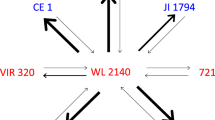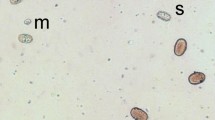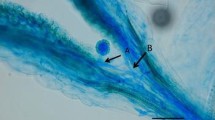Abstract
The basis of low seed set was investigated in a diploid hybrid population with germplasm from the cultivated speciesSolanum tuberosum spp.tuberosum andS. tuberosum ssp.phureja and the wild speciesS. chacoense. Controlled crosses were performed following an incomplete diallel mating design which included the hybrid population and the parental species. Pollen grain germination and pollen tube growth were observed with fluorescence microscopy in 174 intrapopulation and interspecific combinations of genotypes. Fifty percent of the combinations of genotypes within the hybrid population and 46% of those between this population and the parental species were incompatible; overall, 71% of the interspecific combinations of genotypes were compatible when plants of the hybrid population were used as females, vs. 5% when used as males. Although the site of reaction could vary in a given intrapopulation or interspecific cross with the combinations of genotypes, pollen tube inhibition occurred in the first third of the style in 42% of them. Since the gene pool of the hybrid population had been widened with germplasm from other geographic areas and the genotypes ofS. tuberosum ssp.tuberosum, S. chacoense andS. tuberosum ssp.phureja used in this study were not the ones involved in the original crosses, it is concluded that the S-locus is not controlling the incompatibility reaction but rather that a cross-incompatibility system, possibly governed by more than one locus, is acting.
Resumen
Se investigó la base de la producción baja de semilla en una población híbrida diploide con germoplasma de las especies cultivadasSolanum tuberosum ssp.tuberosum yS. tuberosum ssp.phureja y la especie silvestreS. chacoense. Los cruzamientos controlados se realizaron siguiendo un diseño dialélico incomplete, el cual incluyo la población híbrida y las especies parentales. Se observa la germinacién del grano de polen y el crecimiento del tubo de polen con un microscopio de fluorescencia en 174 combinaciones intrapoblacionales interespecificas de genotipos. El 50% de las combinaciones de genotipos en la población híbrida y el 46% de aquéllas entre esta población y las especies parentales fueron incompatibles; en total, el 71% de las combinaciones interespecíficas de genotipos fueron compatibles cuando las plantas de la población híbrida se usaron como hembras vs. el 5% cuando se usaron como machos. Aunque el lugar de reacción podría variar en en cruzamiento intrapoblaciónale interespecifico dada con las combinaciones de genotipos, la inhibición del tubo de polen se dio en el primer tercio del estilo en el 42% de ellas. Desde que el acervo de genes/de la población híbrida se amplió con germoplasma de otras areas geográficas y los genotipos deS. tuberosum ssp.tuberosum, S. chacoense y S. tuberosum ssp.phureja empleados en este estudio no fueron los involucrados en los cruzamientos originales, se concluye que el locus S no controla la reacción de incompatibilidad sino que esta un sistema de incompatibilidad cruzada, posiblemente controlado por mas de un locus.
Similar content being viewed by others
Literature Cited
Abdalla, M.M.F. and J.G.Th. Hermsen. 1972. Unilateral incompatibility: hypothesis, debate and its implication for plant breeding. Euphytica 21:3247.
Bhojwani, S.S. and M.K. Razdan. 1983. Plant Tissue Culture: Theory and Practice. Development in Crop Science (5). Elsevier, Amsterdam Oxford New York Tokyo; 502 p.
Camadro, E.L. and S.J. Peloquin. 1981. Cross-incompatibility between two sympatric polyploidSolanum species. Theor Appl Genet 60:65–70.
De Maine, M.J. 1994. The ploidy composition of offspring fromSolanum tuberosum (4x) xS. phureja (2x) crosses with special reference to triploid frequencies. Ann Appl Biol 125:361–366.
Dionne, L.A. 1958. Dichlorophenoxyacetic acid as an aid to seed production when widely separatedSolanum species are crossed. Nature 181:361.
EEA Balcarce, INTA - FCA, UNMP. 1989. Papa y Hortalizas. Informe de Actividades del Departamento de Agronomía. Balcarce, Argentina; pp. 45–53.
EEA Balcarce, INTA - FCA, UNMP - Chacra Experimental de Barrow. 1991. Hortalizas y Papa. Informe de Actividades del Departamento de Agronomía. Balcarce, Argentina; pp. 36–41.
EEA. Balcarce, INTA. 1993. Informe del Plan de Trabajo “Utilización de mayor variabilidad genética en el mejoramiento de la papa”. Balcarce, Argentina.
Fritz, N.K. and R.E. Hanneman, Jr. 1989. Interspecific incompatibility due to stylar barriers in tuber-bearing and closely related nontuber-bearing Solanums. Sex Plant Reprod 2:184–192.
Grun, P.and M. Aubertin. 1966. The inheritance and expression of unilateral incompatibility inSolanum. Heredity 21:131–138.
Hanneman, Jr., R.E. and S.J. Peloquin. 1967. Crossability of 24-chromosome potato hybrids with 48-chromosome cultivars. Eur Potato J 10:62–73.
Hanneman, Jr., R.E. and J.B. Bamberg. 1986. Inventory of tuber-bearingSolanum species. University of Wisconsin, College of Agricultural and life Sciences, Bull. 533: 216 p.
Hermsen, J.G. and E. Sawicka. 1979. Incompatibility and incongruity in tuber-bearingSolanum species.In: Hawkes, J.G., R.N. Lester and AD. Skelding (Eds.). The Biology and Taxonomy of the Solanaceae. Academic Press, London, UK; pp. 446–453.
Hermundstad, S.A. and S.J. Peloquin. 1985. Male fertility and 2n pollen production in haploid-wild species hybrids. Am Potato J 62:479–488.
Hogenboom, N.G. 1979. Incompatibility and incongruity inLycopersicon.In: Hawkes, J.G., R.N. Lester and AD. Skelding (Eds.). The Biology and Taxonomy of the Solanaceae. Academic Press, London, U.K. pp. 435–444.
Hougas, R.W. and S.J. Peloquin. 1958. The potential of haploids in breeding and genetic research. Am Potato J 35:701–707.
Howard, H.W. and M.S. Swaminathan. 1952. Species differentiation in the genusSolanum sect. Tuberarium with particular reference to the use of interspecific hybridization in breeding. Euphytica 1:20–28.
Johnston, S.A., T.P.S. den Nijs, S.J. Peloquin, and R.E. Hannmenan, Jr. 1980. The significance of genie balance in endosperm development in interspecific crosses. Theor Appl Genet 57:5–9.
Leue, E.F. and S.J. Peloquin. 1980. Yield and relative maturity of diploid F1 hybrids of haploids x wild species. Am Potato J 59:475–476.
Liberal, M.T. 1966. Fertilidade de populasoes em F1 e F2 envolvendo haploides deSolanum tuberosum L. e diversa especies diploides. Pesq Agrop Bras 1:165–172.
Magoon, M.L., D.C. Cooper, and R.W. Hougas. 1958. Cytogenetic studies of some diploid Solanums section Tuberarium. Am J Bot 45:207–221.
Martin, F.W. 1958. Staining and observing pollen tubes in the style by means of fluorescence. Stain Technol 34:125–128.
Masuelli, R.W. and E.L. Camadro. 1997. Crossability relationships among wild potato species with different ploidies and Endosperm Balance Numbers. Euphytica 1–9.
Peloquin, S.J. 1983. Genetic engineering with meiotic mutants.In: Pollen: biology and implication for plant breeding. Mulcahy, D.L. and E. Ottaviano (Eds.). Elsevier, New York. pp. 151–155.
Ross, H. 1986. Potato breeding-problems and perspectives. Parey, Berlin. pp. 10–20.
Sala, C.A. 1993. Incompatibilidad cruzada entre cinco especies tuberosas deSolanum (Solanaceae). Darwiniana 32(14): 15–25.
Simmonds, N.W. 1963. Abbreviations of potato names. Eur Potato J 6:186–189.
Sonnino, A. 1984. Anther culture and its uses in potato breeding.In: Innovative methods for propagating potatos. Report of the XXVIII Planning Conference, Dec. 10–14, 1984, International Potato Center (CIP), Lima. pp. 319–335.
Summers, D. and P. Grun. 1981. Reproductive isolation barriers to gene exchange betweenSolanum chacoense andS. commersonii (Solanaceae). Am J Bot 68:1240–1248.
Ugent, D. 1966. Hybrid weed complexes inSolanum sect. Tuberarium. Ph.D. Thesis, UW-Madison. U.S.A
Author information
Authors and Affiliations
Additional information
Abbreviations according to Simmonds (1963).
Endosperm Balance Numbers (Johnstonet al., 1980).
Rights and permissions
About this article
Cite this article
Camadro, E.L., Verde, L.A. & Marcellán, O.N. Pollen-pistil incompatibility in a diploid hybrid potato population with cultivated and wild germplasm. Am. J. Pot Res 75, 81–85 (1998). https://doi.org/10.1007/BF02883881
Accepted:
Issue Date:
DOI: https://doi.org/10.1007/BF02883881




